Investigative report details murky accounting of well-funded stormwater program.
By Derek Gilliam/Suncoast Searchlight and Michael Barfield/Florida Trident
Original Air Date: July 2, 2025
Host: Sarasota County’s stormwater system is designed to steer floodwaters away from homes and businesses and safely to the coast. But when Debby hit, the system was unprepared when it mattered most—not because the system was overwhelmed but because those in charge neglected to protect it. That’s according to an investigation by the Florida Trident and Suncoast Searchlight. Derek Gilliam reports.

Derek Gilliam: Tropical Storm Debby didn’t look like trouble—just forecasts, quietly urgent, calling for historic rain.
Sarasota County officials were not alarmed. Days before landfall, the public works director went on vacation. Two years earlier, Spencer Anderson had called the county “one of the most flood-protected communities in the state, if not the nation.”
On August 5, the rain came. Then the flooding. Then the reckoning.
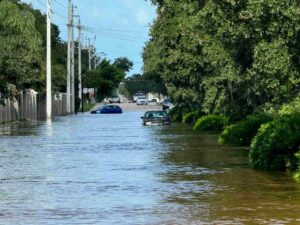
Floodwaters from Tropical Storm Debby inundate a Sarasota County street in August. Photo courtesy of Sarasota County via Suncoast Searchlight.
In the Laurel Meadows neighborhood, foul-smelling water swept through dozens of homes. In the Amish-Mennonite community of Pinecraft, Phillippi Creek overflowed its sediment-choked channel. One man died after floodwaters from the creek swallowed his vehicle. In a business park near Celery Fields, floodwaters submerged and destroyed millions of dollars’ worth of machinery.
Debby proved Sarasota County’s stormwater system unprepared when it mattered most—not because the system was overwhelmed but because those in charge neglected to protect it, an investigation by Florida Trident and Suncoast Searchlight found.
To pinpoint what went wrong, reporters spent five months reviewing thousands of public records, including county emails, maintenance logs, financial records, consultant studies, aerial footage and meeting transcripts. They interviewed public officials, current and former county employees, stormwater engineers, environmental consultants and flood survivors.
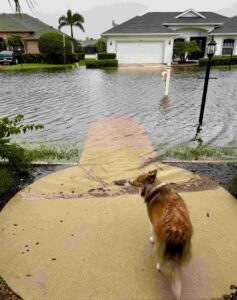
Allison Cavallaro’s dog, Vinny, stands in front of the family’s Laurel Meadows home after Tropical Storm Debby caused mass flooding in the neighborhood in August. Photo courtesy of Allison Cavallaro via Suncoast Searchlight.
Among the findings:
- Despite repeated warnings about sediment buildup in Phillippi Creek—the county’s largest watershed—county officials denied for years that maintaining it was their responsibility. In an interview with reporters in June, they finally conceded it was. The work, they said, had no dedicated funding—even with millions of dollars in stormwater reserves.
- The county’s stormwater division was unprepared and understaffed. Key positions sat vacant for months. Protocols meant to prevent flooding, like opening a gate at Celery Fields, went unfollowed, exacerbating the damage. Maintenance of stormwater infrastructure, including cleaning ditches and unclogging pipes, was backlogged for as long as eight months. The team operated in crisis mode—reacting to problems instead of preventing them.
- One of the worst failures unfolded just half a mile from the county’s own stormwater field services center. A berm, which functions like a levee, near the Laurel Meadows community had not been inspected in decades. After a portion of it gave way, floodwaters surged into homes, forcing evacuations and causing extensive damage.
- County leaders knew about the glaring vulnerabilities in their stormwater system years earlier but did little to address them. A 2022 report by Wood Environment & Infrastructure Solutions warned the county it lacked the staff, resources and long-term planning to maintain existing infrastructure, let alone meet rising demand. It also outlined a series of proposed fixes. Many were delayed or ignored. Staff did not revisit the Wood report for more than two years and only after reporters asked questions about its status.
Now, one month into hurricane season, the stakes are only higher. The next storm could arrive at any moment. Many of the vulnerabilities exposed by Debby remain unresolved.
Steve Suau is a hydrologist and engineer who helped create the county’s stormwater utility in the late 1980s. He spoke during a community flooding meeting in April.
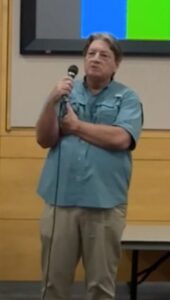
Steve Suau
Steve Suau: There needs to be a change in the culture at stormwater. The commissioners, at the end of the day, make policy and direction. Honestly, I think all the commissioners have this as a priority and understand the urgency.
DG: Staff, on the other hand, he added, may not fully grasp what went wrong during last year’s flooding or recognize that reform is necessary.
SS: I don’t know if it’s going to change from the bottom up through staff, because in some ways, I don’t even know if they really understand what happened last year and understand that there need to be some changes.
DG: At the request of the county, Suau conducted an independent analysis of neighborhoods hit hardest by Tropical Storm Debby. He said he wasn’t surprised by the flooding. What concerned him was where—and how severely—it struck.
In several areas, including Laurel Meadows, Celery Fields and Pinecraft, Suau found, the damage exceeded what rainfall alone could explain.
SS: What it turns out is, every single one of those areas, the reason they flooded worse was because of a lack of maintenance or operation of the system.
DG: There’s no question Debby delivered a rare and punishing storm. Even well-functioning systems would have been tested under that kind of pressure.
In a series of interviews, Sarasota County Public Works Director Spencer Anderson insisted that no system could withstand the up to 14 inches of rain Debby brought in a single day.
Sarasota County’s system, he noted, was designed for only 10 inches of rain in a 24-hour period—the highest standards in Florida.
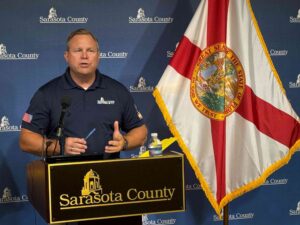
Spencer Anderson.
Yet even as he defended his department, Anderson admitted crucial mistakes: neglecting routine inspections and forgetting to maintain the failed berm near Laurel Meadows. “If we would have known about that area and that it required maintenance, we would have done something better out there,” Anderson said.
He denied that staffing shortages or disarray within the stormwater division impacted the outcome of the flooding, contending the county’s response was appropriate given real-time conditions.
Anderson has been arguing that stormwater management has been underfunded. But county staff did not disclose a $10 million surplus in 2022 when they recommended—and secured—the first rate hike since 2009, nor did they mention it earlier this year when they sought a second as-yet-unapproved hike.
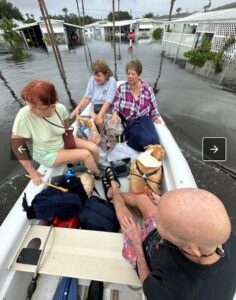
Residents and their dog evacuate by boat through a flooded Sarasota County neighborhood after Tropical Storm Debby inundated streets in August. Photo courtesy of Sarasota County via Suncoast Searchlight.
Instead, staff told county commissioners the stormwater system was underfunded and overstretched, unable to keep pace with new development, tighter federal regulations and the rising threat of sea-level rise.
Within two years of the rate hike’s effect, the surplus had swelled to nearly $19 million.
Yet when residents demanded to know why Phillippi Creek hadn’t been dredged before it flooded homes during Debby, county officials insisted there was no dedicated money to do so.
They not only had the money; they had known for years that sediment buildup in the creek was a problem. Residents had warned them. So had elected officials.
Reporting for Suncoast Searchlight, this is Derek Gilliam. Michael Barfield of the Florida Trident was a co-author on this report.
Host: To read the full investigative report, go to suncoastsearchlight.org/sarasota-county-stormwater-shakeup-new-department or floridatrident.org/sarasota-county-stormwater-crisis-sparks-major-shakeup-after-public-trust-erodes.
WSLR News aims to keep the local community informed with our 1/2 hour local news show, quarterly newspaper and social media feeds. The local news broadcast airs on Wednesdays and Fridays at 6pm.